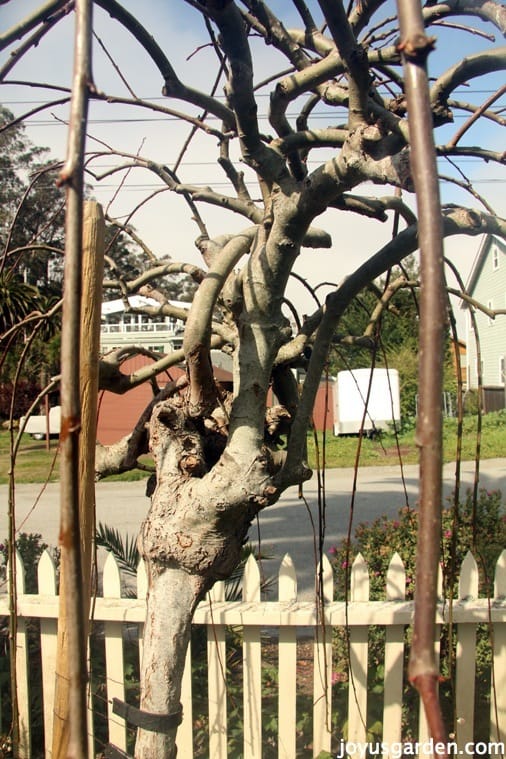The Pruning Of A Weeping Pussy Willow
This is how the Weeping Pussy Willow looked at the end of March 2014. As you can see, it’s developed a beautiful structure.
Here’s the alternate title to this post: How To Make Good On A Bad Prune Job. This Weeping Pussy Willow tree, or Salix caprea “pendula”, has been growing in my client’s garden for about 11 years now. I’m no longer her full time gardener as I’ve since moved south to Santa Barbara.
Over the years I’d been artfully pruning and training it but at the end of 2011 it got hacked by the new gardener (what?!). On five of my subsequent visits to this garden I’ve done restorative and cosmetic pruning. Much to my surprise it’s come back to its glorious self much faster than I thought.
A Weeping Pussy Willow tree is a plant not often seen in gardens here in California. My client, who lives just south of San Francisco, had been her eye on the one in the Wayside Gardens catalogue and finally ordered her coveted specimen. It arrived in a 2 gallon grow pot wrapped in paper and stood about 4′ tall.
We planted it with lots of compost in the moistest part of the garden where the all the water naturally drains off the hill. It had been growing slowly, and with 3 careful prune jobs a year, had developed a beautiful trunk form with a nice shape. So it was much to my surprise when I paid a visit in November of 2011 to discover that it had been “pruned” into what you see below. Action was required!
This is the Pussy Willow “blob” in November 2011. Hey, where’s the weeping?
We had affectionately call this plant “Cousin Itt”, but after a bad haircut, Itt had turned into Bozo The Clown! A weeping tree or shrub like this should be thinned out or just taken off the ground a bit – not all the way back to the trunk. The very same applies to a climbing roses as it takes them a good amount of time to climb and that’s what you want.
The picture above was taken in November of 2011 and fortunately some of the new branches had already started to weep by Spring. In May of 2012 I whipped out my Felcos and pruning saw. I’ll take you on a step by step on how I got this Weeping Pussy Willow back to its glory days.
A close-up showing how thick that new growth was.
I went in and took out a lot of that new growth. You must take it all the way back to a main branch or the trunk otherwise all those shoots will appear again. I also removed some of the older main branches to open it up and bring it back to an interesting form.
In the meantime, Cousin Itt had really started to lean because of the strong winds in this area so a lodge pole stake was pounded in to straighten him back up.
Here’s how looked after I was done. I left just a bit of the new growth shooting upward because we do want it to grow taller.
A close up of the inner structure after I pruned it this past Spring. As you can see, I’ve taken a lot out.
Lots of new shoots always appear on the trunk. Those shoots, the smaller ones coming off the main weeping branches and a portion of the ones heading upward need to be removed too. They’ll spoil the beautiful weeping form (and isn’t that the reason why you buy a plant like this?) as it’ll looks better when it’s thinned out a bit.
These standard plants are sold grafted and will never get significantly taller than the height you bought it at. And this is exactly why the Weeping Pussy Willow will never get as tall as the upright Pussy willow.
I’ve since done a post and video about how I care for a Weeping Pussy Willow tree which you might find helpful. I share all I know about it and outline the care tips.
I did a couple of rounds of restorative pruning letting it grow between each one. Then I started in on the cosmetic pruning and this Weeping Pussy Willow looks dandy as can be. Make sure you know how a plant grows and how long it takes to recover before you have at it with the pruners!
A Link To Help You Out:
Before you tackle a job like this make sure your pruners are clean & sharp.
This post may contain affiliate links, you can read our policies here.
- About the Author
- Latest Posts
Nell, the founder of Joy Us garden, was born into a gardening family and grew up in Connecticut’s countryside. After living in Boston, New York, San Francisco, & Santa Barbara, she now calls the Arizona desert home. She studied horticulture & garden design, working in the field all her life. Nell is a gardener, designer, blogger, Youtube creator, & author. She’s been gardening for a very long time & wants to share what she’s learned with you.












Hi Tracy – Pussy Willows are tough as you can see here. Your care questions are answered in this post I recently did: https://www.joyusgarden.com/weeping-pussy-willow-care-tips/ In terms of height, they grow slowly. Just leave the branches that are growing upwards & yours will get taller. /the 1 that you see in these posts was under 4′ when I planted it & now it’s around 8′ tall. Nell
Hi Nell,
I wrote you May 24th and told you my saga about the frost and my weeping pussy willow. Well the latest update is that my tree is still absolutely bald, not a leave on any of the well trimmed branches. However, I am pleased to report that there are leaves growing out of the ground at the base of the tree (suckers). Will my tree come back next year? Can I transplant/grow a tree from the suckers? Should I trim back these suckers like I typically do on my healthy tree?
Hi Diane – The suckers are coming from the grafted trunk, which is Pussy Willow bush stock so the answer is no. You can’t grow a tree from those. I always take them off. I really can’t tell you if your tree will come back or not because I don’t know all the conditions which caused it. If you scratch the wood at the end of summer & it’s still green, there’s a very good chance it will. Nell
I received a shoot about 3 ft tall planted it in the fall of last year
Then in the spring it looked to be dead I removed the branches off the stalk and left the stalk now it has grown what I think is a new stalk and it is about 5 ft tall and new growth at ground level is this normal ? What should we do with it
My email is [email protected]
Hi Ernie – Are you talking about a shoot which has come off the base of your Weeping Pussy Willow? It’s not quite clear from your comment/question. Nell
I am so grateful to find your site. I think I have been pruning my Weeping Pussy Willow all wrong, among other things. Its planted on a slight slope and always wanted to lean down hill and when we staked it and kept it upright for a year or so, the trunk now has (on the downhill facing side) like a ripped, torn scar going down the entire length of the trunk. The sides of the scar look kind of folded in towards the tear. It still continues to produce lots of new growth be extremely bushy but it hasn’t produced catkins in a few years, which makes me so sad. I pruned it up off the ground into a shorter parasol shape the year before last thinking the foliage was just too heavy for it and it just got wider and wider! Now after watching your videos I know why! I pruned it again this week (which I now read is too early…face palm), taking a lot of the under growth out and letting it weep a little more hoping that will help it. I know I have probably tried to help it a little too much but any another advice? Especially to encourage it to bloom catkins? Thank you SO much for your time!
Hi Melissa – I’m glad you found our site also. I always thin this WP out really well after flowering (because the flowers form on the growth from the previous season) & then a couple of lighter prunings throughout the season. There are a couple of reasons yours may not be flowering: not enough light, improper pruning (taking off too much of the previous season’s growth) or you simply have a bad graft. Nell
Hi Nell–the branches on “Willow” are turning brown and not leaves are growing on them. The deer eat the leaves on the side facing the road. Should I prune them back or is it too close to winter for a hard prune?
Hi Leni – I’m not sure where you live but there should be enough time to do a pruning. I wouldn’t do too hard a pruning now, just a light or moderate 1 dpending on the age of the plant. Nell
Hi
I am not sure how to prune my weeping pussy willow. I can’t seem to post a picture here. So I will try and describe it to you.
The willows are going from white fuzzy to yellow pollen type buds, but above them are still small white fuzzy buds.
Do I trim off the yellow pollen buds just above them?
Thanks
kim